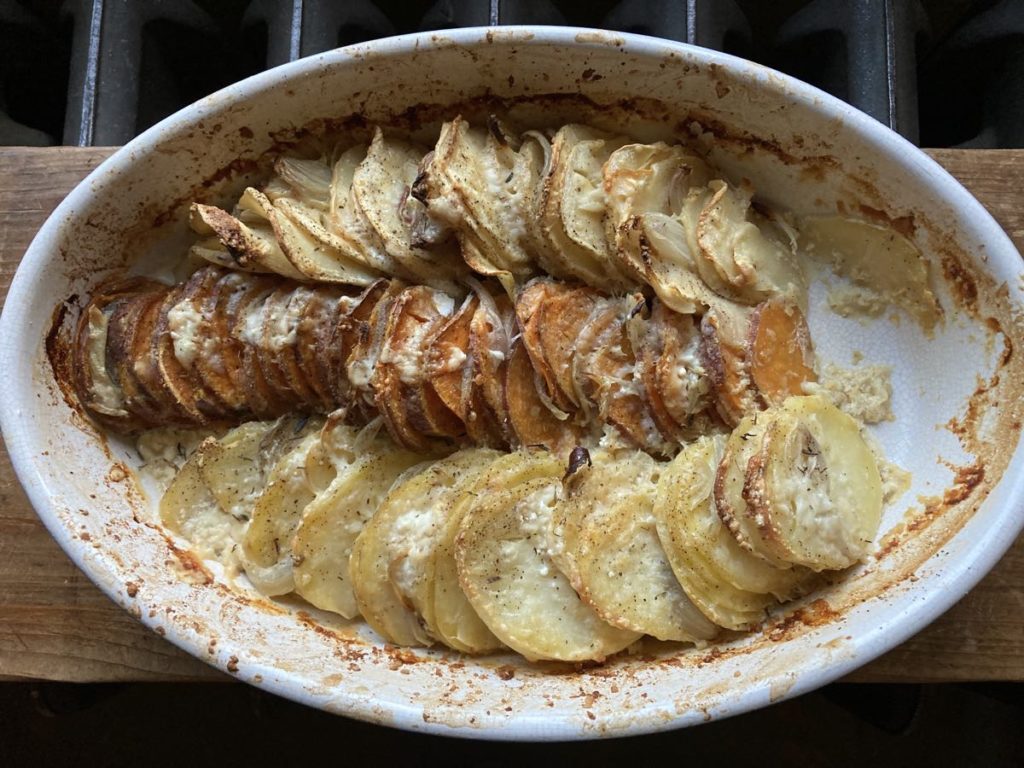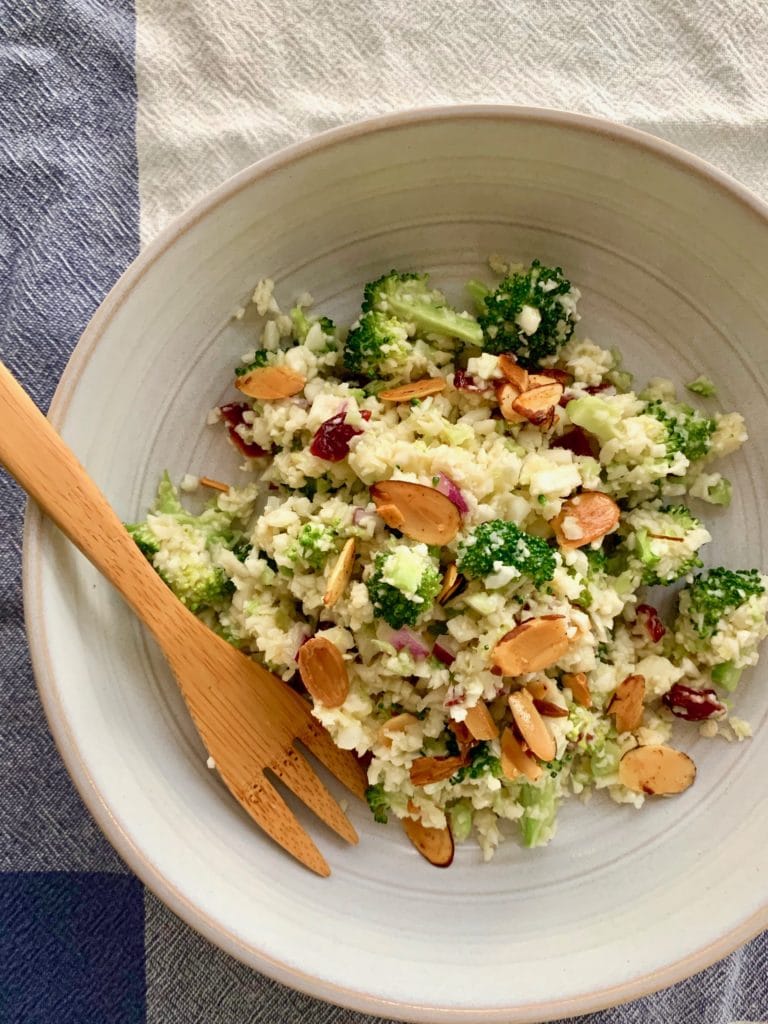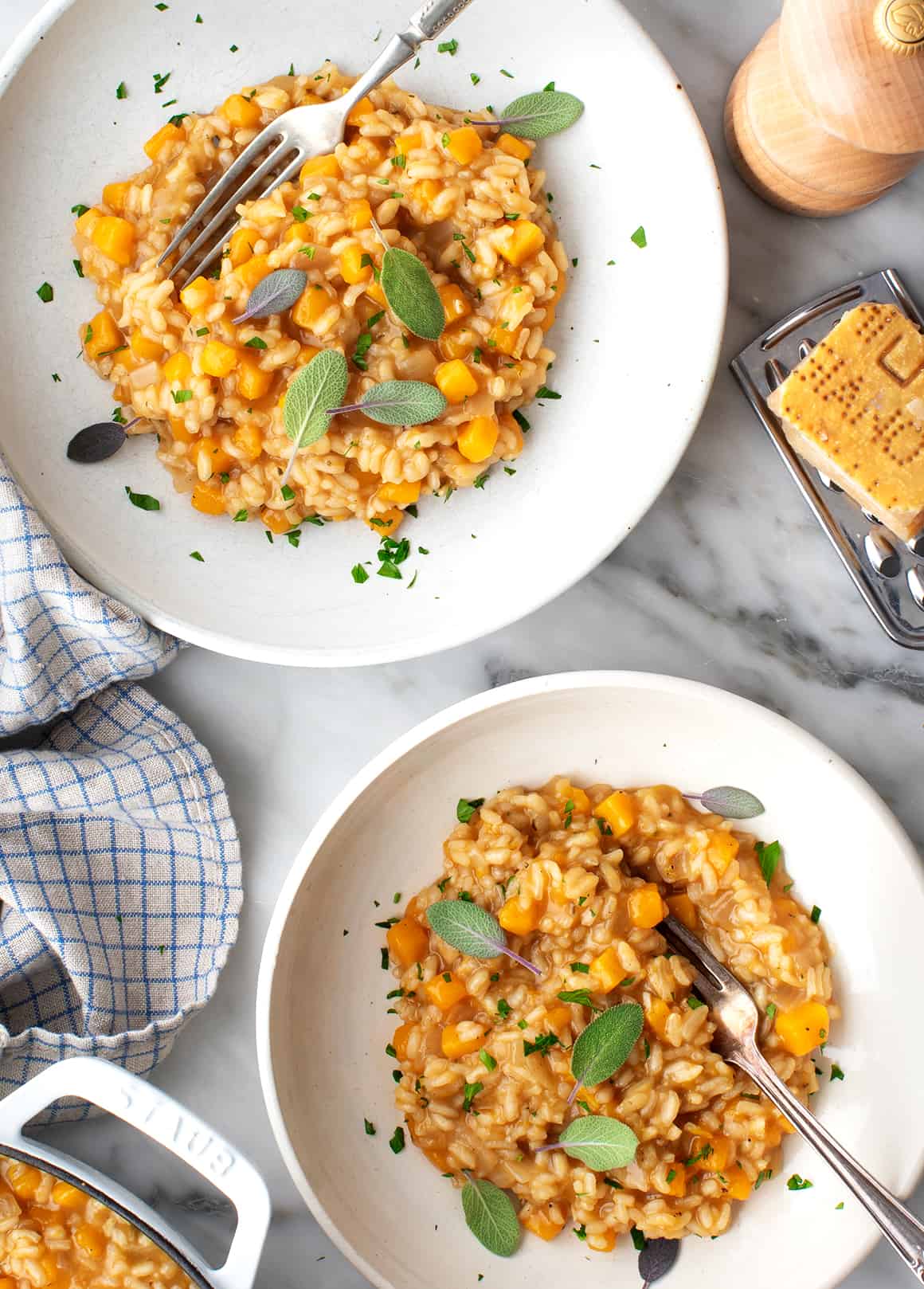Monthly Archives: November 2021
Storage Share, Nov 18/19, 2021
- On: November 17, 2021
 0
0
Good bye for now!
Thank you so much for joining our farm this season. We hope you stay safe and warm this winter, and that this big delivery brightens your winter meals.
Beth and Steve
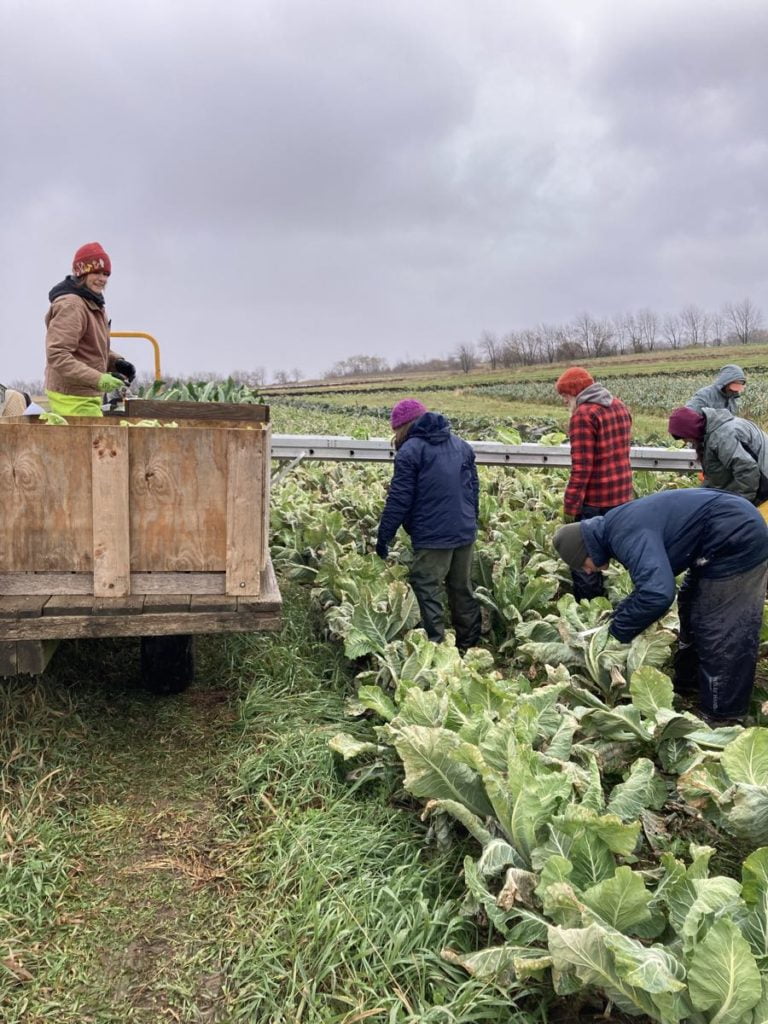
We’ve packed both cauliflower and Romanesco in the Storage shares. These crops were late this year because of the warm weather in September and October but the heads sized up eventually! The outer leaves were nipped by frost but the heads were not.
Storage Share this week
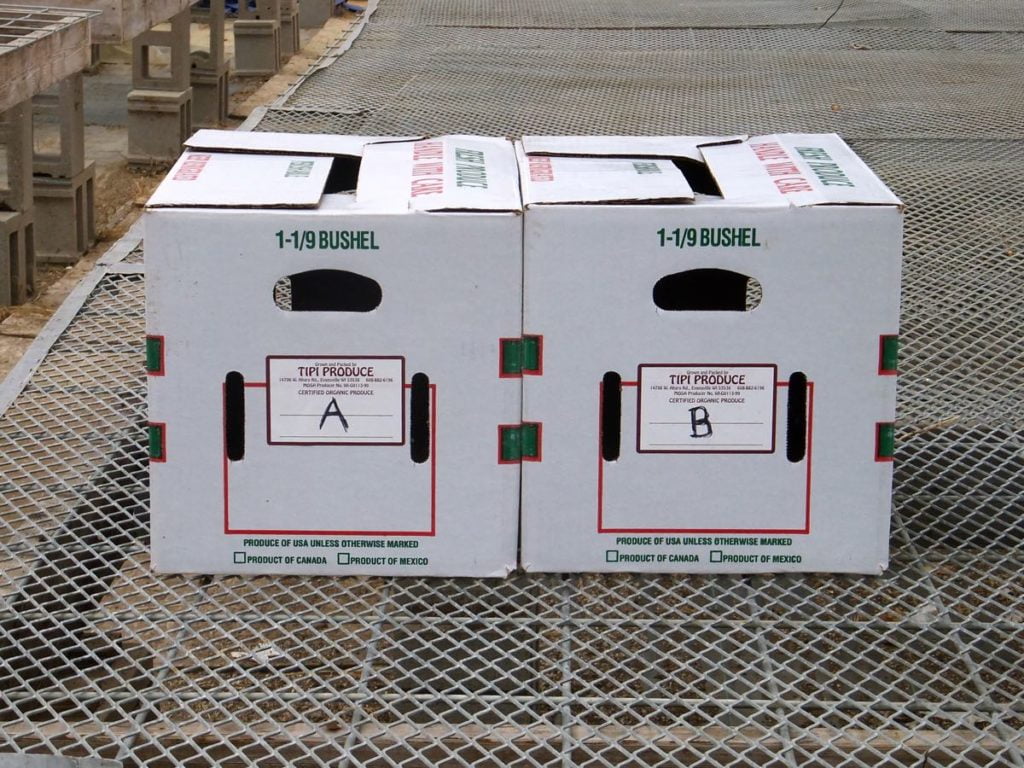
Your produce is in one box labelled “A” and one box labelled “B”. Bring lots of bags and containers.
Things you need to know about your winter share
* Your delivery will consist of two different boxes, labeled “A” and “B”. Take produce from one “A” box and one “B” box. The boxes contain different vegetables.
* Please pick up your boxes on the day of delivery, during the normal hours for your site.
* Bring extra bags or containers this time. Leave the Tipi boxes at your site, take the produce home in your own bags/containers.
* If you send someone to pick up your produce, make sure they know what to do.
Strategy
We hope you enjoy this shipment of veggies. Strategize to use them well, as some will last longer than others.
* These are the most perishable vegetables: Brussels sprouts, cauliflower.
* These are the next-most perishable: Leeks, Romanesco. Keep an eye on your butternut, potatoes and sweet potatoes. The last two are susceptible to drying out. Expect the largest butternuts to last the longest.
* These will last the longest: beets, cabbage, carrots, celeriac, garlic, red & yellow onions, parsnips and shallots.
Veggie List (Nov. 18/19, 2021)
Box “A”
Everything in this box can be stored cool or at room temperature. See notes below for more detail.
(Combined squash & sweet potatoes weigh 20 to 22 lb.)
Butternut squash, several
Special winter squash (‘Autumn Frost’ OR ‘Winter Sweet’)
Sweet potatoes, mixed ‘Beauregard’, ‘Covington’ & ‘Orleans’
Russet potatoes, 5 lb
Shallots, ~1 lb
Garlic, 3 – 4 bulbs (in shallot bag)
Box “B”
Refrigerate everything in this box, except the onions.
Beets, 3 lb
Brussels sprouts, 1 lb
Carrots, 5 lb
Cauliflower, 1 medium head
Celeriac, 1
Green cabbage, 1 head
Leeks, ~2.25 lb
Onions, 5 lb total
….. a mix of red ‘Blush’ and yellow onions
Parsnips, ~2 lb
Romanesco cauliflower, 1 medium head
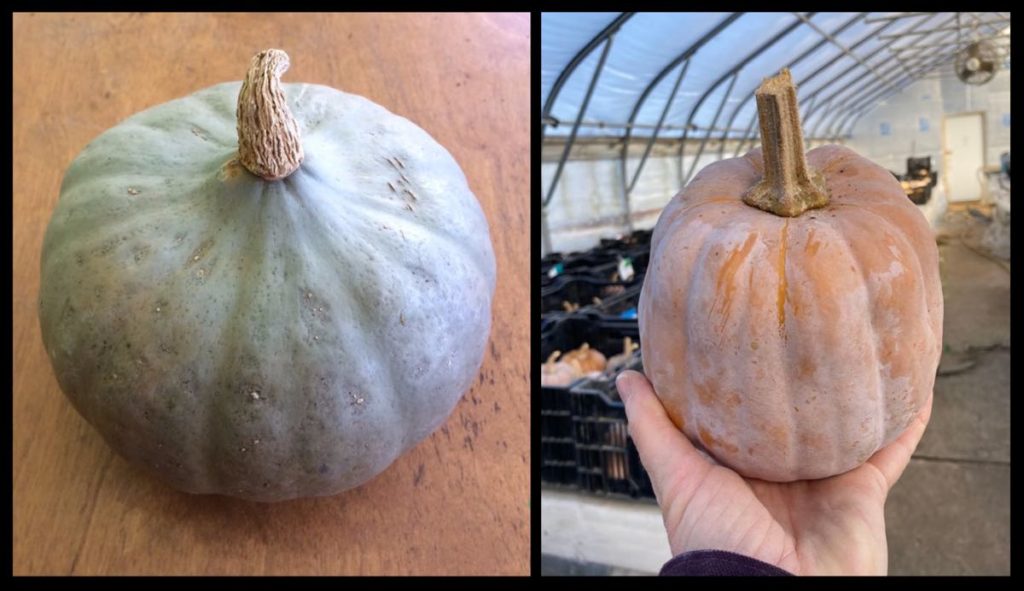
Everyone gets Winter Sweet (left) OR Autumn Frost squash (right) plus several butternuts.
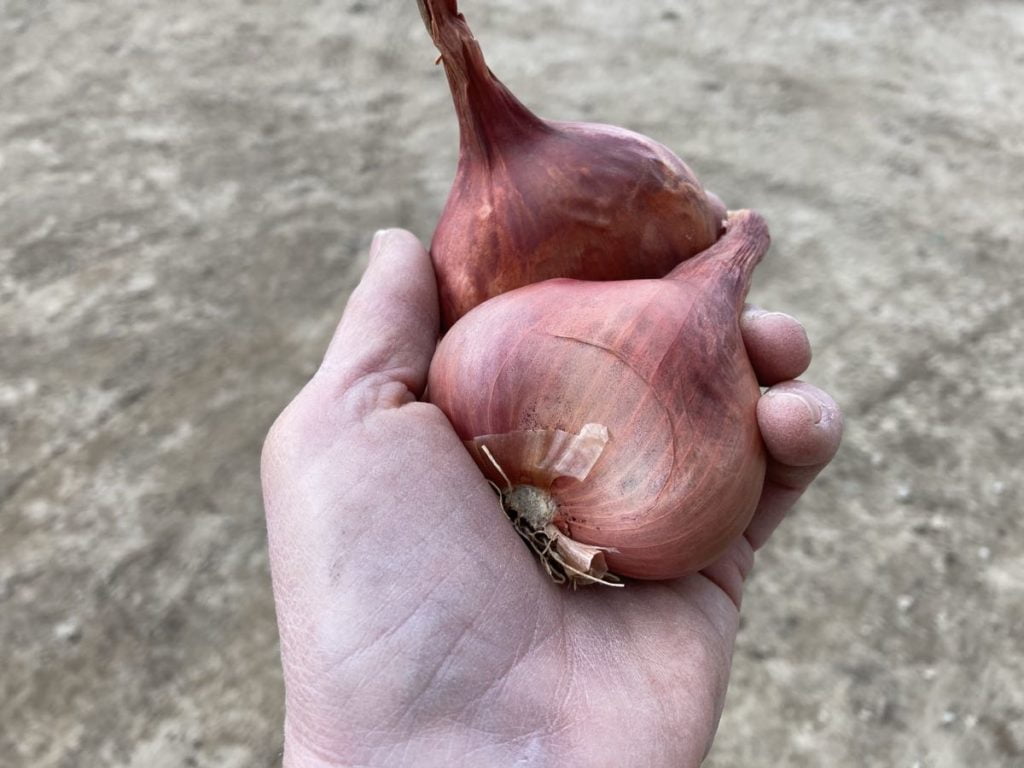
Shallots. Yours are packed in a paper bag with the garlic.
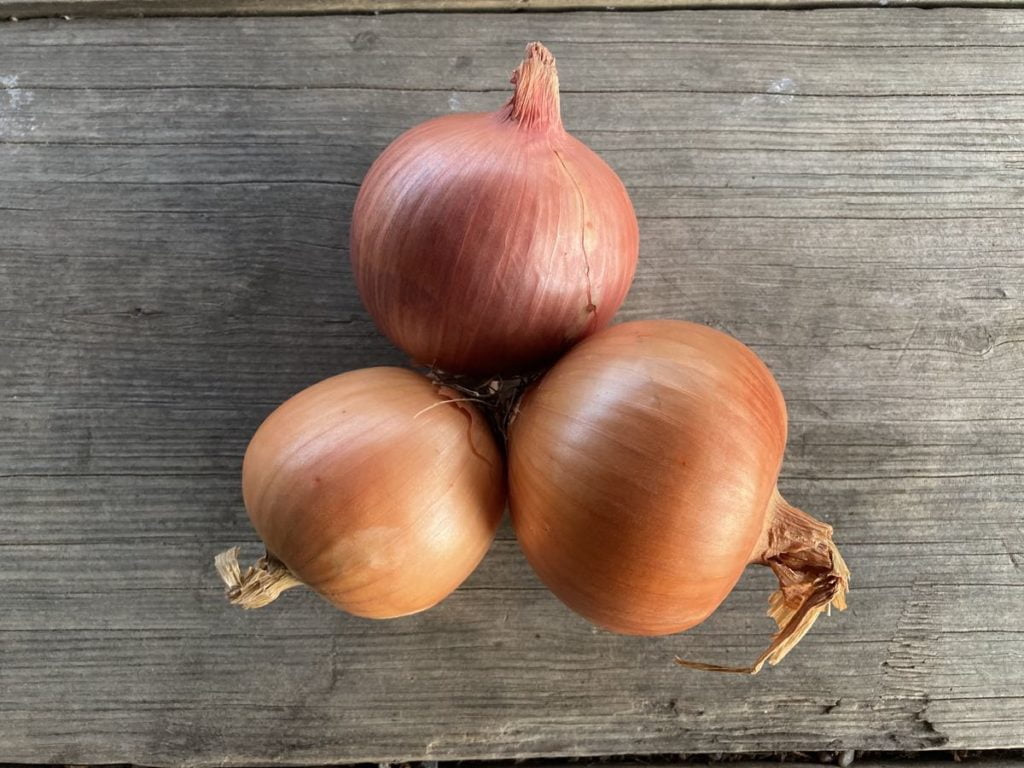
Top, ‘Blush’ red onion
Bottom, yellow onions
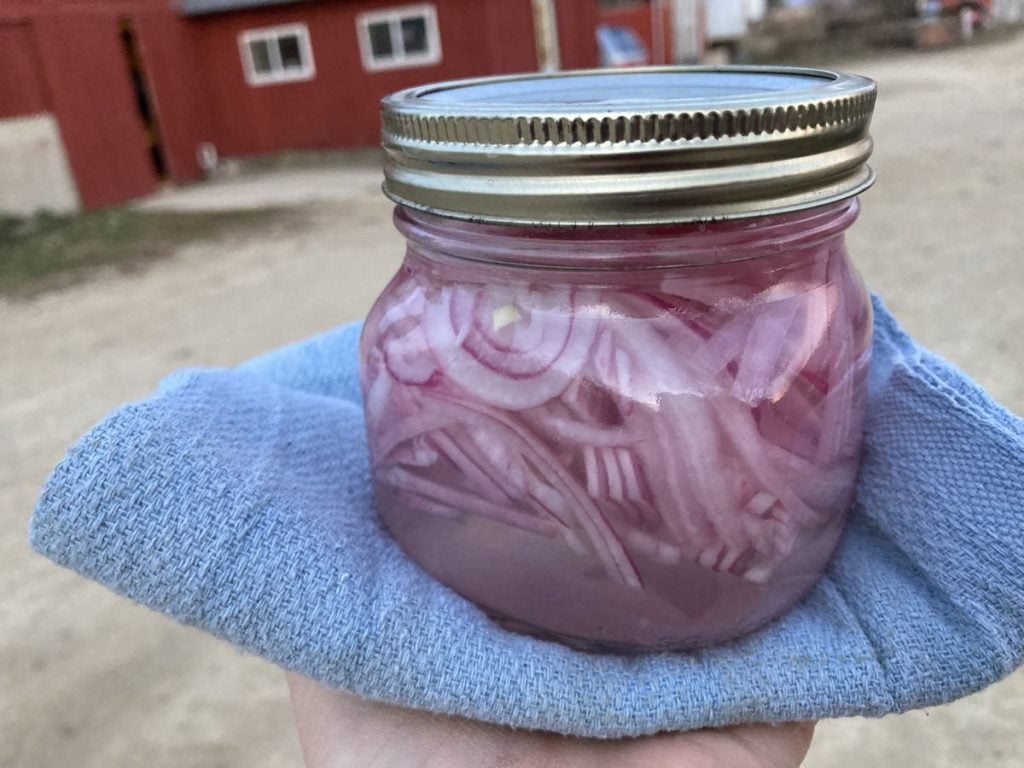
The ‘Blush’ onions are more pink than red, and excellent for long storage.
Beets – Refrigerate in a bag or container. Beets will store for two months or longer.
Brussels sprouts – Eat within 2 to 3 weeks.
Cabbage – Refrigerate.
Carrots, orange. Refrigerate in a plastic bag. Will keep for several weeks.
Cauliflower – Refrigerate. These should store for two weeks. Don’t be alarmed by the frost damage on the wrapper leaves. The heads are fine.
Celeriac – Will store for months in your fridge. Cut off chunks as needed. Peel before using. I find it easiest to cut the celeriac into flat slices, then peel.
Garlic – Store at room temperature. Some of your bulbs might be in halves. We continue opening the bulbs to check for any internal problems.
Green cabbage – Refrigerate. These are big. It’s OK to cut off chunks as needed.
Leeks. Refrigerate. In general, leeks are not a long-storage crop. You may need to strip off one or two outer leaves to freshen the leeks before you cook them.
Onions: Refrigerate or store in a cool, dark spot and protect from light. Exposure to light stimulates sprouting.
Parsnips (These look like large white carrots.) – Refrigerate in a plastic bag. Parsnips will store for several months but will darken in color. That is a harmless change.
Potatoes; russets – Can be stored at room temperature or in a cool spot, but must be kept in the dark so they do not turn green. A cloth or loose plastic bag draped over the paper bag will slow moisture loss, but do not close the plastic bag. Potatoes store longer if kept cool. Around 40 – 50 F is ideal. These potatoes were grown by the Igl family near Antigo.
Russets– We got the big ‘baking’ grade so you have nice bakers for Thanksgiving. Excellent for baked or mashed potatoes.
Romanesco cauliflower (beautiful chartreuse green, spiraled head) – Refrigerate. These should store well, eg for a few weeks.
Shallots (look like small red onions) – Good for salad dressing. We’re still learning how to grow shallots and are thrilled to have a small bag for everyone!
Sweet potatoes – We’re sending a mix of two indistinguishable varieties, Beauregard and Covington. Both have excellent flavor and sweetness. Store at room temperature, no lower than 55 F, but 60+ F is better. Keep them on your kitchen counter where it’s easy to keep an eye on them. I like to keep ours in a paper bag so they don’t dehydrate. Cook promptly if they start to soften. The roots come in a wide ranges of sizes and all are good.
WINTER SQUASH – Store all winter squash cool and dry. 60 F is ideal. Do not put in a plastic bag. Check your squash regularly and eat promptly if flaws develop.
Autumn Frost (For some sites, frosted pumpkin) – These beautiful frosted squash have both pumpkin and butternut squash breeding in them. They cook and taste like an unusually good butternut, with rich, smooth texture. They are quite nice. The skin is elible.
Winter Sweet (For some sites; dark grey) – These storage squash will be ready to eat in December or January. The metal-gray exterior hides deep orange, flaky flesh. Simple preparation is best for this flavorful squash. Cut into slices or chunks, rub with oil and roast in 400 degree oven. We like to eat the squash with a garlic-yogurt dipping sauce. The skin is edible.
Butternut winter squash (All sites; tan, oblong) – We’ve sent several varieties, some of which store better than others. Expect the largest butternuts to store the longest. If your butternuts show signs of drying or wrinkling, use them promptly. They will still taste great, but it’s a sign that they are nearing the end of their storage life. Remember, you can cook, mash and freeze the squash for future use. I find that you can refrigerate cut raw squash for up to one week. This runs counter to the accepted way to store squash, but is useful if you want to cook just half a squash. Some of them are big! Try microwaving your squash for one to two minutes before cutting or peeling. This softens the squash and makes a large butternut easier to handle.
Thanksgiving Menus
It’s time for our annual Thanksgiving menu round-up! Right now, websites are loaded with great recipes suited to your Storage Share vegetables. Peruse and bookmark soon. The Thanksgiving collections are usually taken down quickly after the holiday but individual recipes are not. I’ve gathered a long list of recipes to try this winter.
Smitten Kitchen
I love Deb Perelman! She has an extensive list of Thanksgiving recipes collected over the years. I really trust her recipes.
Food52.com
Once again, the lively Food52.com site has outdone itself with an extensive Thanksgiving recipe collection. They’ve named it “AutoMagic Holiday Menu Maker“. It’s organized by type of dish. Scroll down to these sections for lots of veggie-centric dishes. There are soooo many appealing dishes.
3. Soups & Salads
4. Main Attractions/ Not meat subsection
5. Starchy Things
6. Vegetables
Thanksgiving meals by recent immigrants
https://www.rachaelraymag.com/recipes/a-totally-american-thanksgiving-immigrant-style
In this 2017 post, Rachel Ray asked first- and second-generation American chefs to tell us how they mix cultures and cuisines to create Thanksgiving dinners. The recipes include:
Persian-Style Roast Turkey with Pomegranate-Walnut Gravy
Beet & Tahini Dip (Khlat)
Jerk Sweet Potatoes
.
.
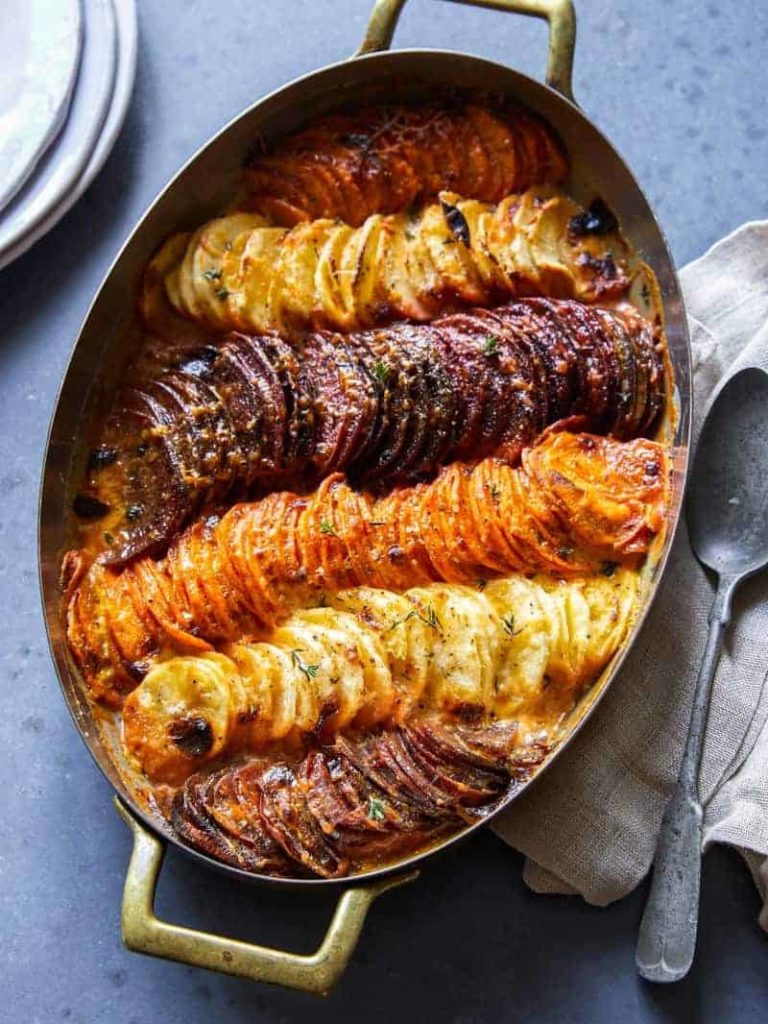
Cheesy Root Vegetable Gratin
From Spoon Fork Bacon
Look at that gorgeous casserole. The recipe has well-thought-out instructions. I have a difficult history with these kinds of dishes (4 hours in the oven, too much butter, etc) but this one worked great. See my version below.
.
.
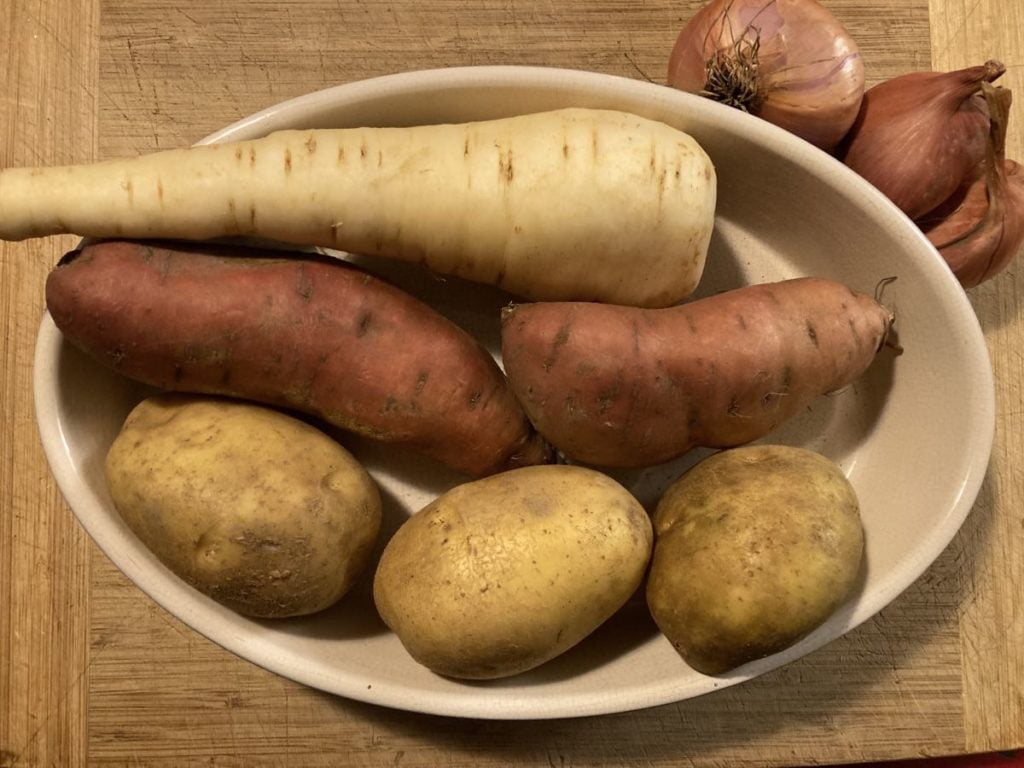
Beth’s Gratin
I made the recipe above with these adaptions and it was still delicious! And pretty!
– I substituted oat milk for the heavy cream but didn’t change the amounts of cheese. Honestly, skipping the cream did not matter.
– I used potatoes, sweet potatoes and parsnips, skipping beets to avoid the bleeding issues described in the original recipe.
– I added sliced shallots between every few slices.
– I baked it covered with foil for 45 minutes, then added gruyere cheese as directed and baked an additional 15 minutes.
It worked well to lay the raw vegetables in my baking dish to judge how much to slice. I used all shown in the top photo except one potato, including the shallots visible at the edge of the dish. We liked all three vegetables but the parsnips were the star so I’m making a sweet potato and parsnip version for Thanksgiving.
Extension Share
- On: November 03, 2021
 0
0
Just three more weeks. Please don’t let it snow!
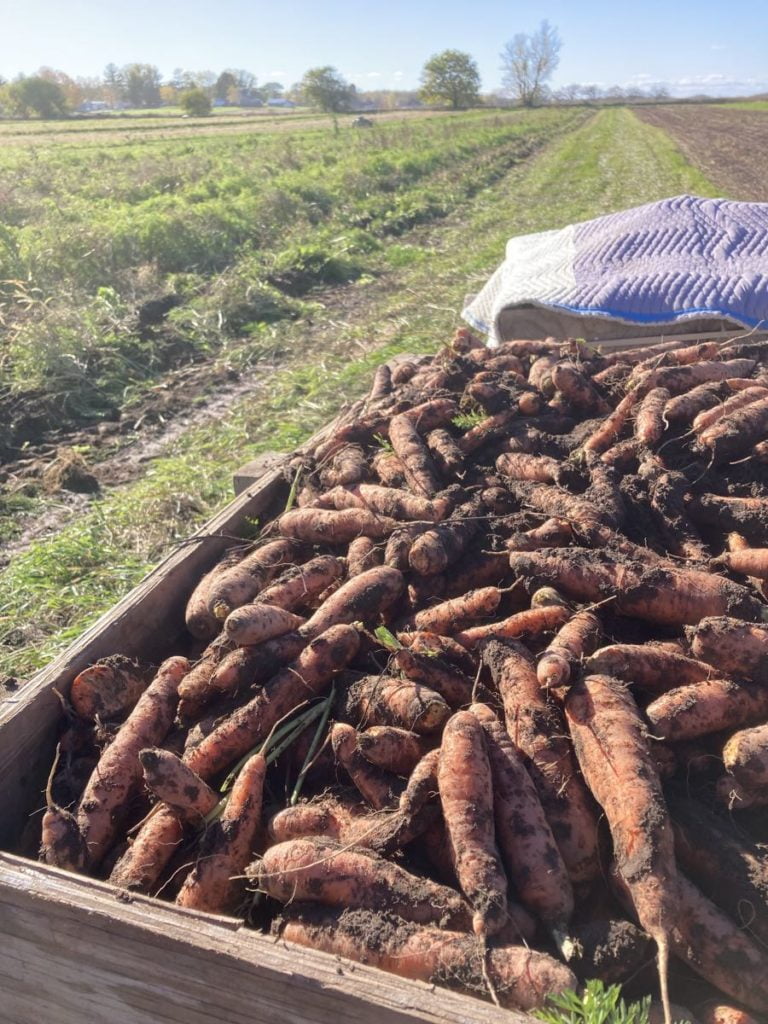
Bins of freshly harvested carrots
With our crew, we surge toward our finish line, harvesting and packing crops into storage. We’re like squirrels, stashing away cabbage and root crops. By Thanksgiving, we’ll be done. This spell of cold weather has forced us to prioritize the more frost-vulnerable crops first. All the celeriac, beets, daikon, rutabaga, napa cabbage are in. We’re still working on carrots, parsnips, cabbage and leeks. They can handle some very cold nights without damage.

Steve and I harvest carrots together most weekends. He steers the harvester from the tractor. I ride the back and keep the carrots flowing into bins. We can harvest a lot, with just the two of us.
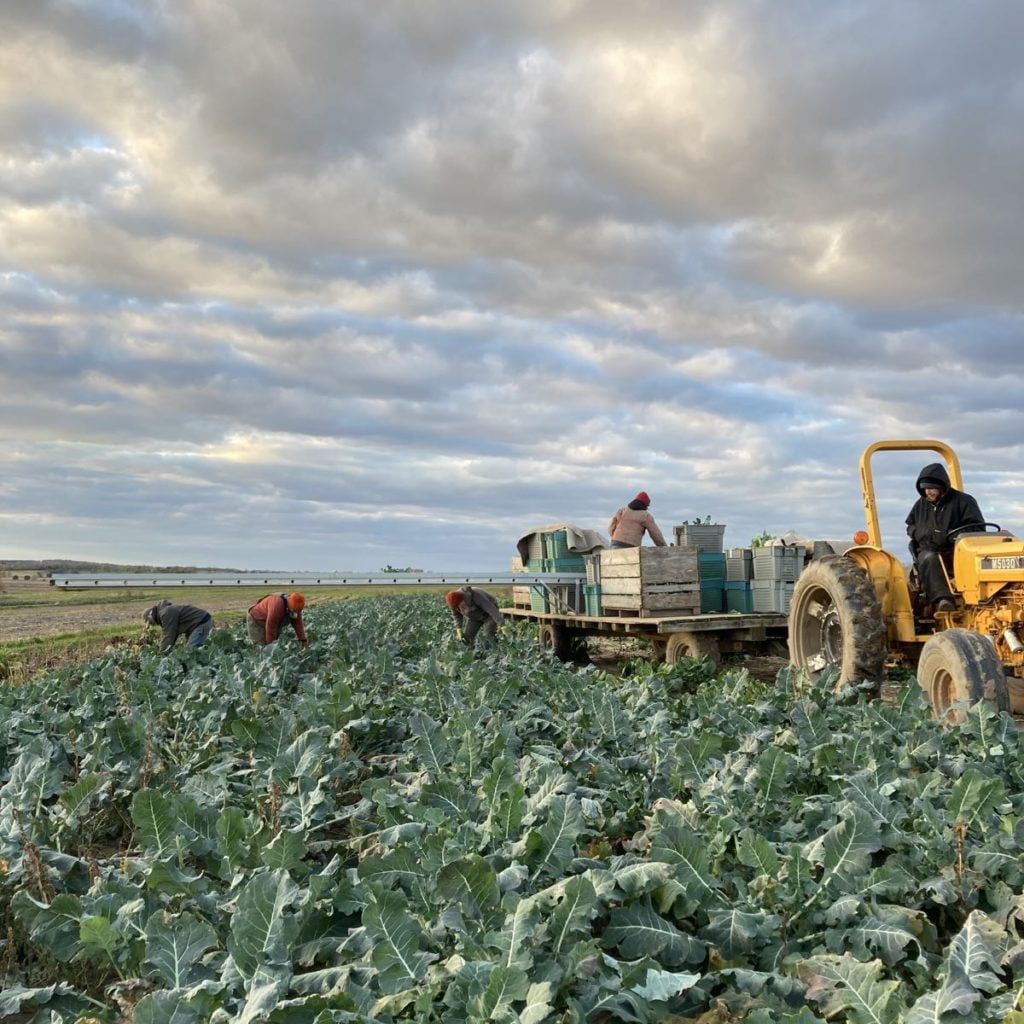
We picked lots of broccoli, cauliflower and some Romanesco for you this week, just before the nights got too cold. Steve, Maggie, Ben and I cut in the field. The conveyor carries the heads to the wagon.
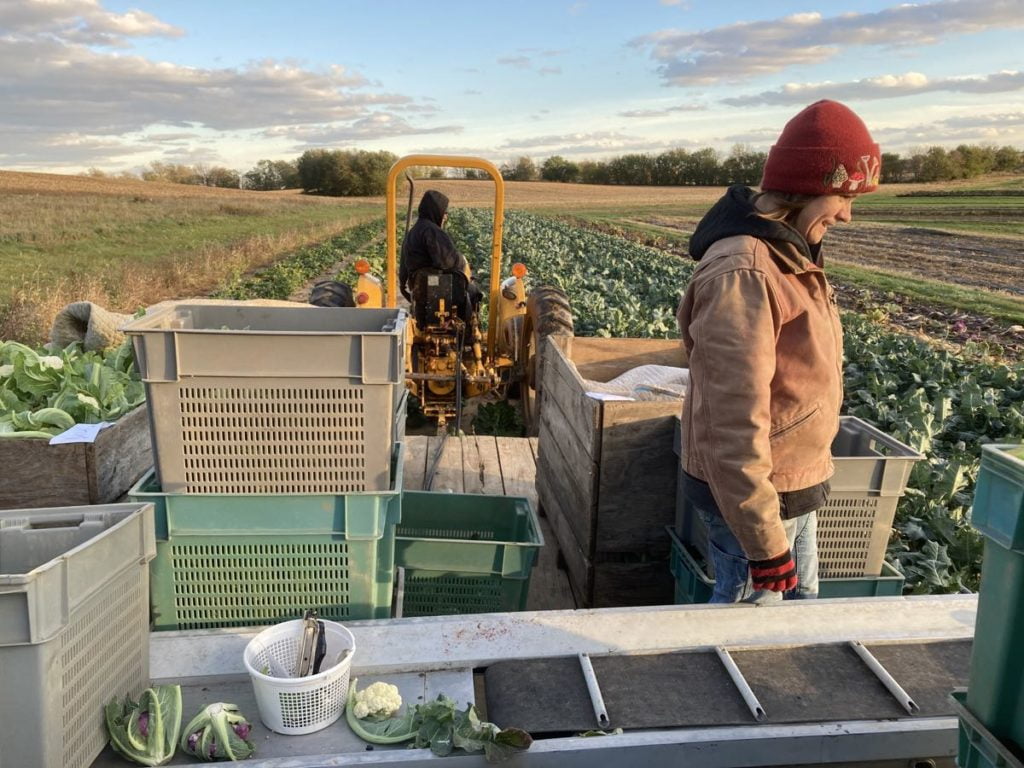
Karen grades and counts the cauliflower from the conveyor belt. So much counting! Mike drives the tractor.
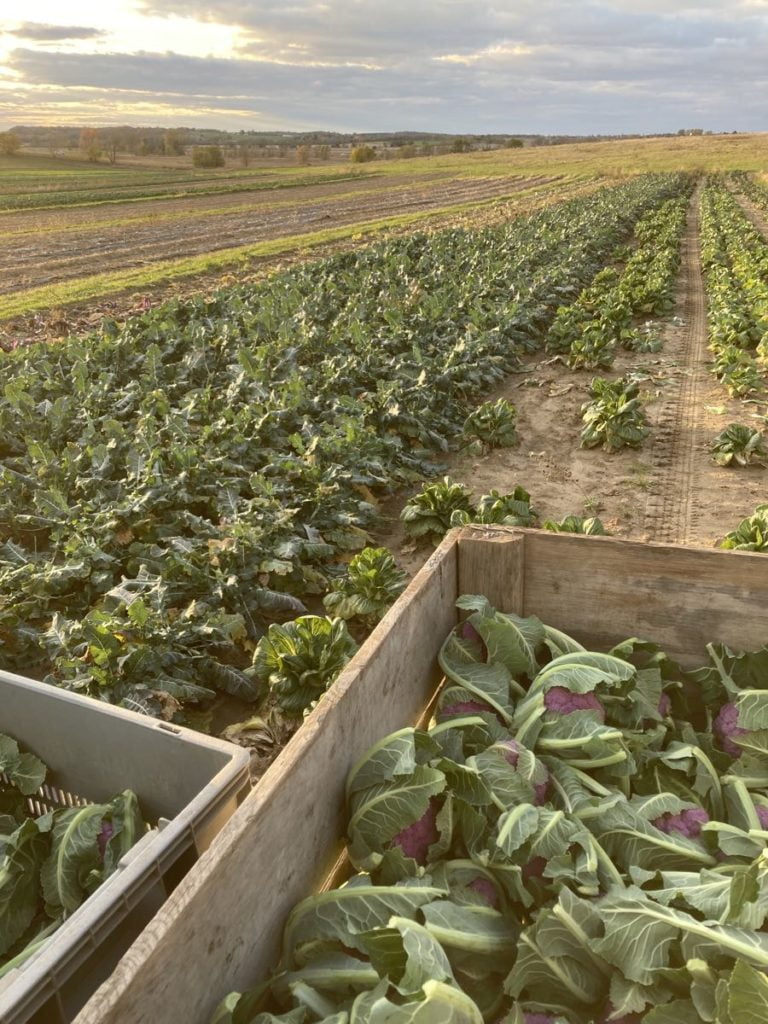
The farm is beautiful in the afternoon light.

Our house is filled with flowers that I cut before the freeze. I bet you all did the same! These are my favorite dahlias.
Veggie List & Veggie Notes
Extension Share
November 4/5, 2021
Winter squash (‘Autumn Frost’ or ‘Heart of Gold’)
‘Orleans’ sweet potatoes, 2 lb
White cauliflower, 1
Purple cauliflower, 1 small
Broccoli, 1 small
Carrots, 2 lb
‘Suntan’ bell peppers, 2
Poblano chiles, 2 (in bag with carrots)
Red onion
Yellow onion
Garlic
By site, you’ll get an additional portion of Romanesco cauliflower OR cauliflower (white or green or purple) OR broccoli.
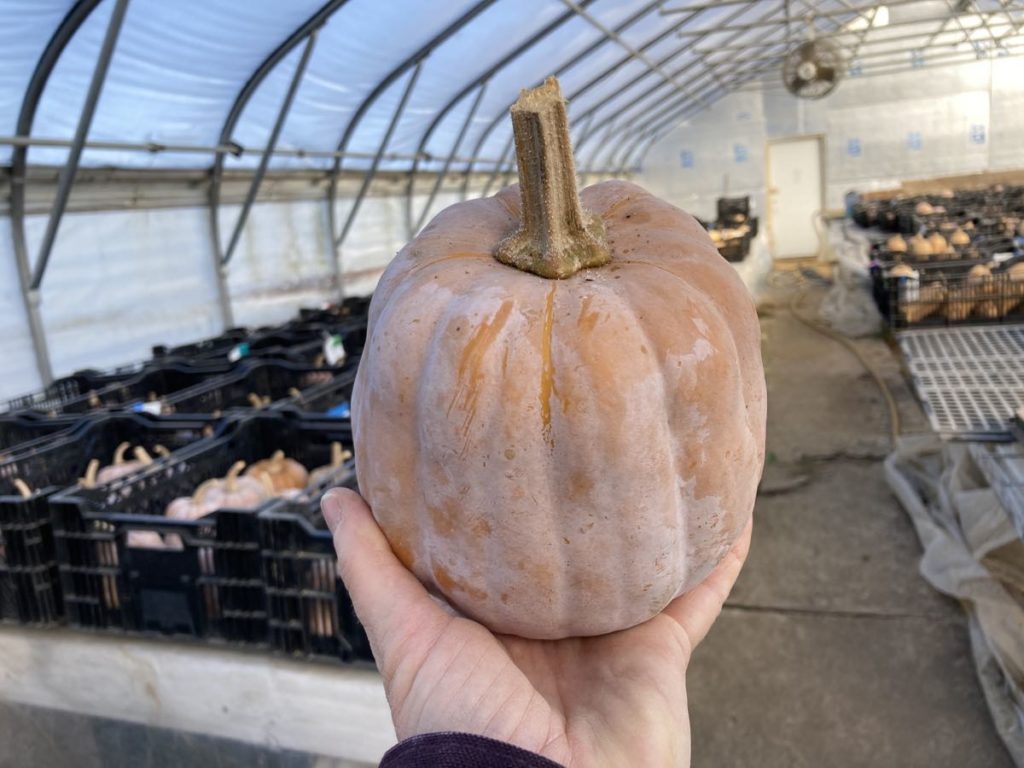
‘Autumn Frost’ squash – Store cool and dry. 60 F is ideal.
This beautiful frosted squash has both pumpkin and butternut squash breeding. They cook and taste like an unusually good butternut, with rich, smooth texture. They are quite nice. The skin is edible. They store very well but you have to keep an eye on them. If you see flaws developing, eat promptly.
‘Heart of Gold’ acorn squash – A few sites get these speckled acorn squash. We’ve trialled this variety a few years and are very happy with its flavor and sturdiness. Eat these soon – acorn squash do not store for long.
Orleans sweet potatoes – Store at room temperature, no colder than 60 F.
We couldn’t wash the sweet potatoes because of the cold weather. We had to drain all the pipes in our pack shed. Therefore, we packed the unwashed sweet potatoes into paper bags, to keep everything else from getting dirty.
Garlic – This is the German Extra Hardy strain.
Medley of cauliflowers, broccoli, Romanesco – Refrigerate.
We have a medley of these crops to share this week. Most people will get a white cauliflower + a small purple cauliflower + something else (unless your cauliflower is unusually large). The warm fall weather delayed these crops. Cauliflower and Romanesco don’t set their heads without cold weather. We’re glad they made it but then we had to pick them small before the freeze.
RECIPES from PHOEBE
Visit our 2020 Recipe Log or our 2019 Recipe Log.
Broccoli and Cauliflower Rice Salad with Honey Mustard Dressing
Tossed in a sweet and tangy honey mustard dressing, this salad is a fresh, fun side dish. You can make it a day or two ahead of time, but wait to add the toasted almonds until right before you eat.
Serves: 4-6
Prep time: 20 minutes, plus 30 minutes marinating
Cook time: 5 minutes
Ingredients
1 small head broccoli (about 1/2 pound)
1 small cauliflower (about 1 pound), chopped
3 1/2 tablespoons extra-virgin olive oil, divided
2 tablespoons Dijon mustard
2 tablespoons apple cider vinegar
1 tablespoon honey
1 garlic clove, grated
1/2 teaspoon sea salt, more for sprinkling
1/4 cup diced red onion
1/2 cup sliced almonds
Big pinch smoked paprika
Heaping 1/4 cup dried cranberries
- Break the broccoli into small florets. Set them aside and roughly chop the stalk. Place the chopped broccoli stalk in a food processor with half the cauliflower and lightly pulse until the vegetable pieces are well-chopped, but not pureed, about the size of grains of rice. Transfer to a large bowl and repeat with the remaining cauliflower.
- Make the dressing: In a small bowl, whisk together 3 tablespoons of the olive oil, the mustard, vinegar, honey, garlic, and 1/2 teaspoon salt.
- Add the second batch of cauliflower, the broccoli florets, and the red onion to the large bowl, and toss to combine. Pour in the dressing, and mix well to coat. Set aside for at least 30 minutes so that the vegetables have a chance to marinate in the dressing.
- Meanwhile, toast the almonds. Line a large plate with paper towels. Heat the remaining 1/2 tablespoon olive oil in a medium skillet over medium-low heat. Add the almonds and cook, stirring constantly, until golden brown and fragrant, 4-5 minutes, turning down the heat as necessary. Remove from the heat and scrape onto the lined plate. Spread in an even layer, sprinkle with salt and smoked paprika, and set aside to crisp and cool for 10 minutes.
- Before serving, fold the dried cranberries into the salad and sprinkle with the almonds. Season to taste and serve.
Roasted Cauliflower Flatbreads
Thanks to toppings like dried apricots, olives, roasted onions, and cauliflower, these flatbreads boast a delicious, unexpected mix of sweet, tangy, and briny flavors. Slice them up and serve them as an appetizer, or enjoy them as a meal on their own. I like to make them with store-bought naan, though if there’s another type of flatbread you like, go ahead and use it instead!
Serves: 4-8
Prep time: 15 minutes
Cook time: 30 minutes
Ingredients
5 cups small cauliflower and/or Romanesco florets (1 pound)
1/2 cup cooked chickpeas, drained and rinsed
1/2 onion, peeled and sliced into thin wedges
1 cup crumbled feta cheese (4 ounces)
3 tablespoons extra-virgin olive oil, more for drizzling
1 tablespoon fresh lemon juice
1 tablespoon water
4 large or 8 small naan or other flatbreads
3 dried apricots, diced
1/4 cup pitted green olives, torn
Zest of 1/2 lemon
Sea salt and freshly ground black pepper
- Preheat the oven to 425°F and line two large baking sheets with parchment paper. Place the cauliflower and/or Romanesco florets on one sheet and the chickpeas and onion wedges on the other. Drizzle with olive oil, sprinkle with salt and pepper, and toss to coat. Spread in a single layer and roast for 25-30 minutes, or until the chickpeas are crisp, the onion is soft and browned, and the cauliflower is tender and browned around the edges.
- Remove the baking sheets from the oven and measure 1/2 cup of the cauliflower florets. Place them in a food processor with the feta, 3 tablespoons olive oil, lemon juice, and water. Process until smooth.
- Meanwhile, warm the flatbreads in the oven. I like to place them directly on the oven racks for 5 minutes, or until slightly browned and beginning to crisp up on the bottom.
- Assemble the flatbreads with a slather of the feta mixture, the remaining cauliflower florets, the chickpeas, onions, dried apricots, and olives. Sprinkle with the lemon zest, season with a few grinds of black pepper, and serve.
Butternut Squash Risotto
From Love & Lemons
Dice up your Autumn Frost squash, and use it in this creamy, comforting fall risotto. If you don’t have rosemary or sage on hand, feel free to skip it. Even without the herbs, this recipe is fantastic.
.
.

Poblano Chicken Fajitas
From What’s Gaby Cooking
Served with tortillas and whatever fixings you like, this fajita recipe is an easy, 1-skillet meal. Toss in the poblanos and bell peppers from your box – any color will be fine!
.
,
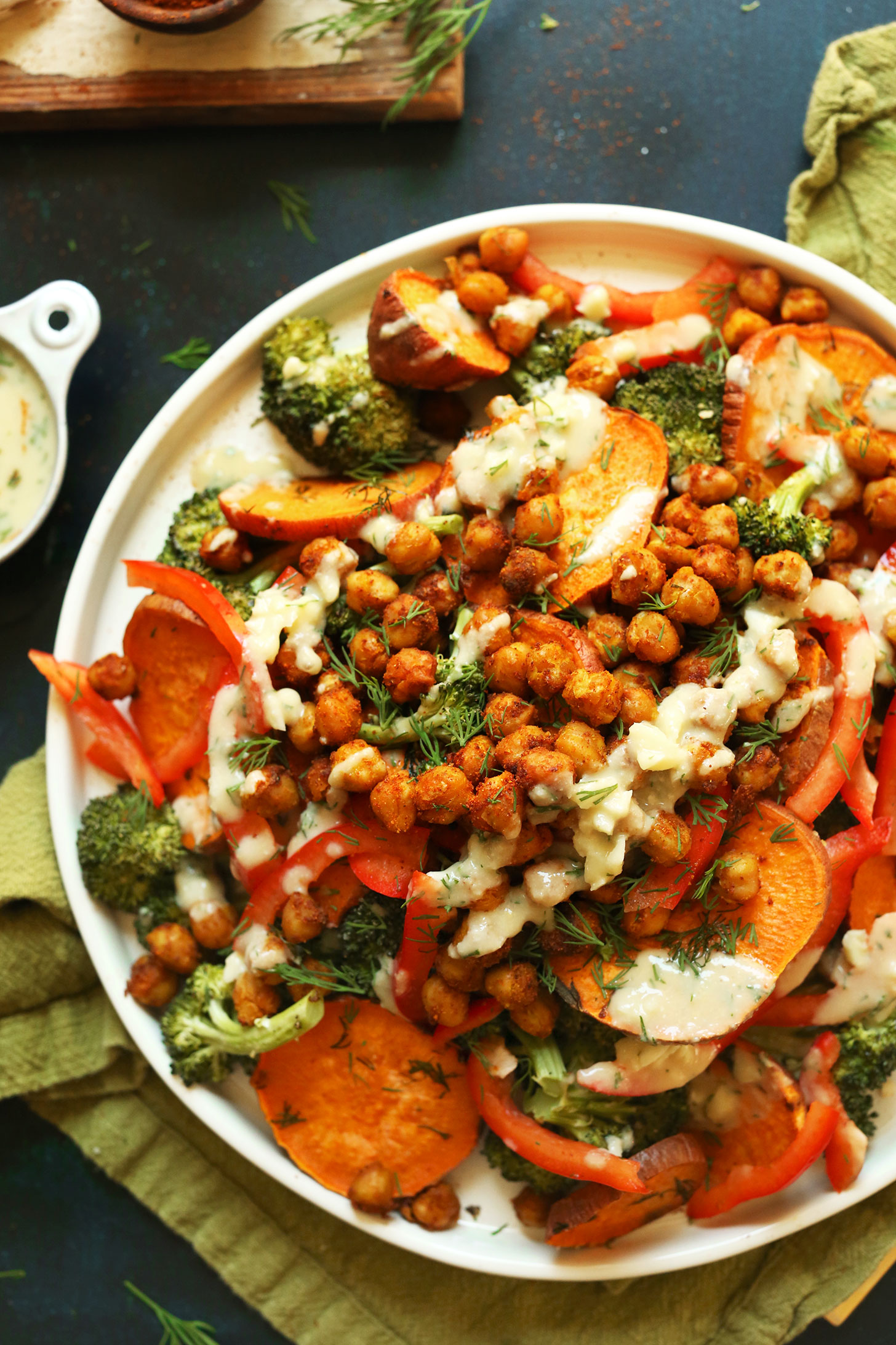
Roasted Broccoli Sweet Potato Chickpea Salad
From Minimalist Baker
This hearty salad would be a great lunch or light dinner. Cauliflower or Romanesco cauliflower would be a fine sub for the broccoli here, or you could use a mix of cauliflower and broccoli.
.
.
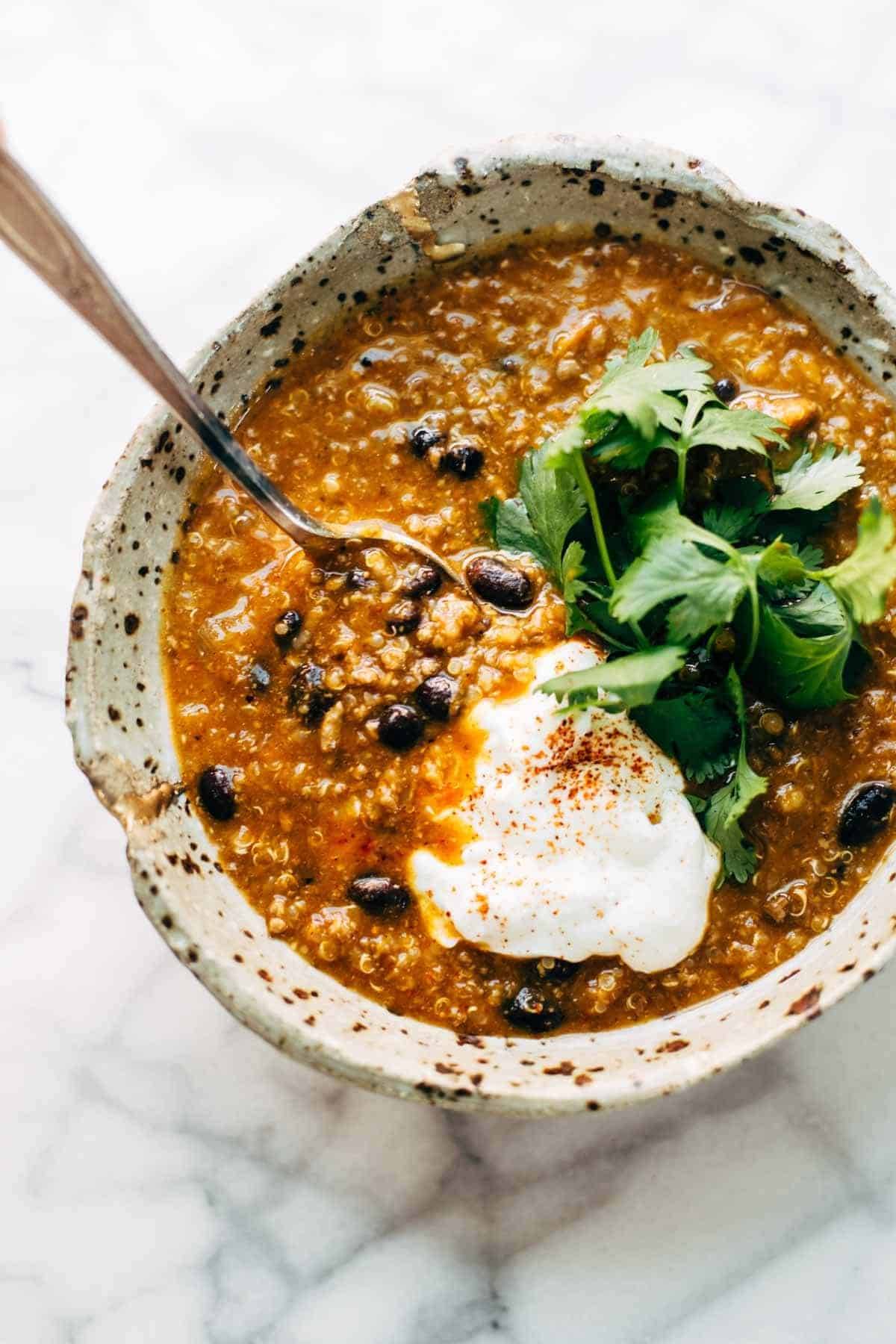
5-Ingredient Sweet Potato Turkey Chili
From Pinch of Yum
Ok, in reality, this recipe is more like 10 ingredients, but it’s super simple nonetheless. Perfect for using this week’s sweet potatoes!
.
.
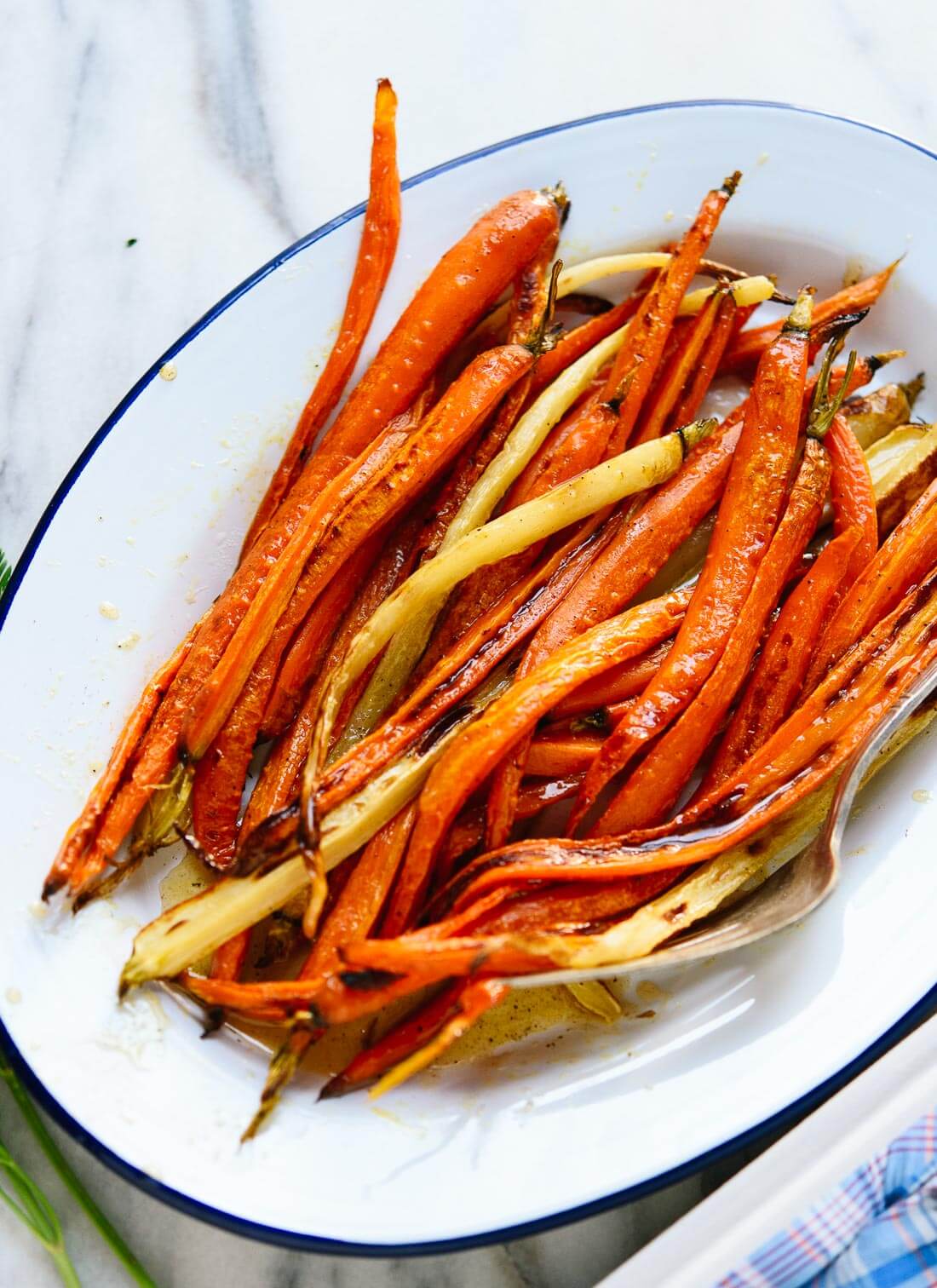
Roasted Carrots with Honey Butter
From Cookie + Kate
A drizzle of honey butter highlights the natural sweetness of these simple roasted carrots.
.
.
Spicy Sesame Carrot Soup with Red Lentils
From The First Mess
Tahini and red lentils give this pureed soup a rich, creamy texture. Serve with crusty bread for a delicious fall meal!


